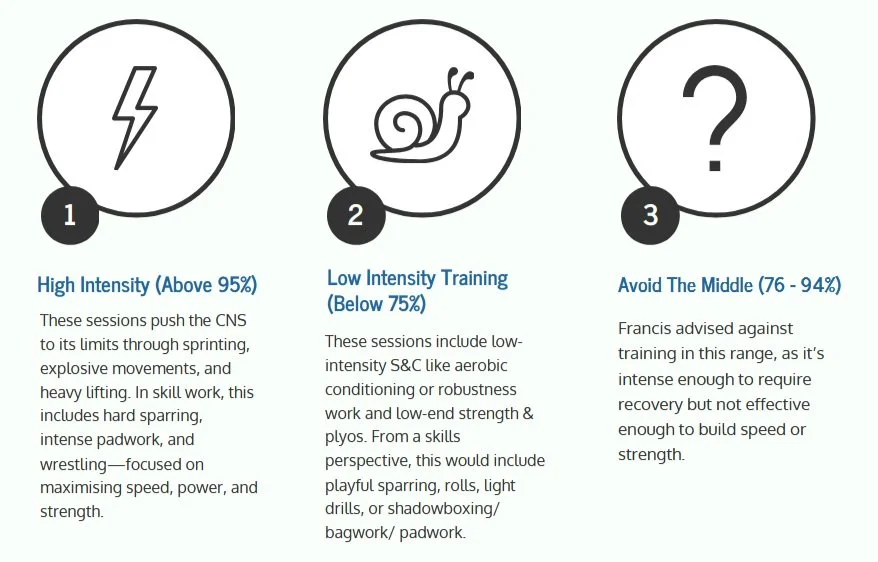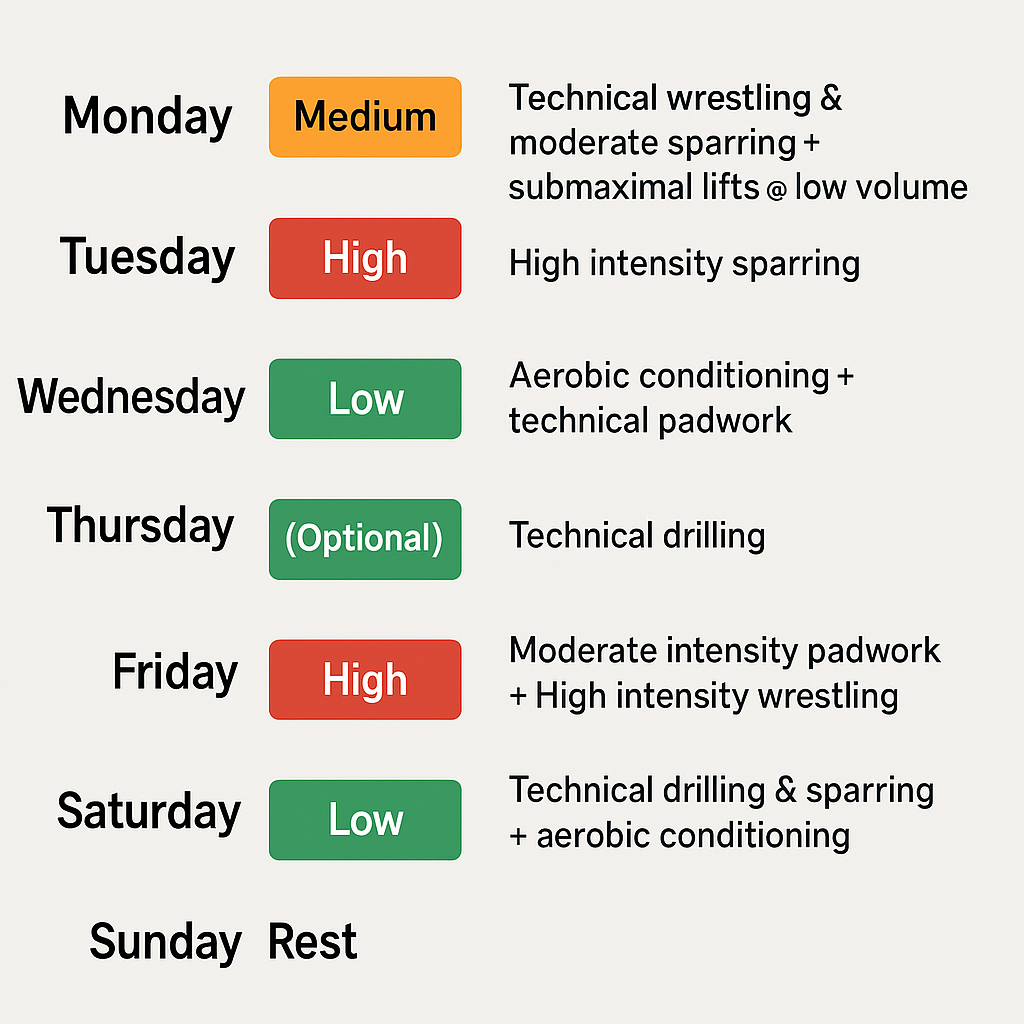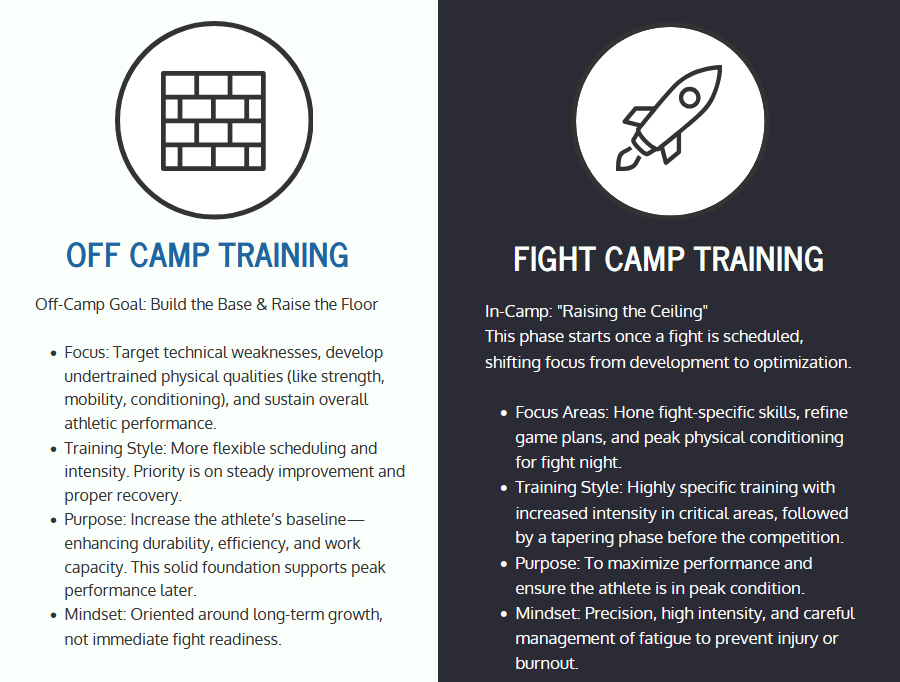Planning Effective Training for MMA
3-5 minute read
Brought to you by Eesa Gilani and Jason Lau
In the high-stakes world of mixed martial arts (MMA), fighters and hobbyists alike use resistance training methods to develop physical qualities to improve strength, power, speed and energy system development.
The answer lies in a strategic approach that focus on the most effective methods that yield the best results. This article explores the nuances of strength and conditioning in MMA, emphasizing the importance of planning effective training that aligns with the sport’s multifaceted demands.
Early in training camps, general athletic development is essential, while the weeks leading up to a fight should concentrate on specific physical qualities that directly impact performance. By navigating these complexities, fighters can better develop their fitness, ensuring they are not only physically prepared but also secures long term development and success.
Overview of MMA S&C
Energy System Development
In mixed martial arts (MMA), fighters use three main energy systems to perform at their best: the Aerobic system, the Lactic system, and the Alactic system. Each system plays a unique role in helping fighters during training and competition.
Strength training
Strength training for combat sports is a foundational physical trait in which injury mitigation, power & speed are built. The greater the force the body can produce, the greater force the body will be able to tolerate. An analogy we like to use is that “strength is a glass of water, and water is the amount of stress the body can tolerate. The larger the glass, the more the body can handle/ tolerate.” Strength training should be present year-round. However, the priority strength training has in a training program differs depending on the training period.
Strength isn’t developed only through resistance training. Skill work—such as grappling and wrestling—also builds strength, just in a less structured and measurable way. This can lead to unpredictable spikes in volume or intensity, increasing the risk of injury or overtraining as a result of unorganized and mismanaged strength development.
A structured strength program outside of skill practice helps streamline progress and manage workload effectively. However, resistance training must be carefully adjusted to account for the physical demands of training in the gym and on the mats.
Power & Speed
High velocity movements are fundamental in striking and takedowns. When it comes to power, there are nuances in the velocity of power-based work. Power and speed have more similarities than differences. Power requires more force or heavier loads while speed is moving lighter loads at high velocities.
Grappling relies on sustained power, while striking is more ballistic and explosive. Power training should focus on high intent and low-repetition sets to minimize fatigue and velocity drop-off. Anaerobic capability involves higher velocity and requires longer rest periods. Movements should be stable and allow the athlete to reach peak velocity. Jumps, throws, and Olympic lifts are good options, provided they match the athlete’s technical proficiency.
Training Structure and Fatigue Management in MMA
Concurrent Training
Concurrent training develops multiple qualities—strength, power, and conditioning—simultaneously, making it beneficial for various athletes, especially MMA fighters. However, the interference effect suggests that excessive endurance training may hinder strength and muscle growth. Research shows this effect depends on factors such as volume, intensity and timing. By managing these variables— such as separating strength and endurance sessions, prioritizing based on each training block, and allowing proper recovery—athletes can minimize conflicting development and simultaneously improve all qualities.
The High-Low Training Method, was created by sprint coach Charlie Francis, is a system that optimizes training intensity to improve performance while reducing the risk of overtraining. It divides workouts into high-intensity and low-intensity days, avoiding the medium-intensity “gray zone” that can lead to fatigue without real benefits. A brief breakdown of the system is as follows:
Revised Medium Intensity Sessions
We propose adding medium-intensity days to account for the unpredictability of MMA training. Unlike sprint training, which has controlled variables like speed, intensity, and structured rest, MMA lacks this consistency. A strict high/low training model isn’t always practical, so incorporating medium-intensity days provides more flexibility. However, these should be used sparingly and with a clear purpose to drive meaningful adaptations.
Medium-intensity days can include a mix of skill work and strength and conditioning (S&C) or be dedicated to one. For example, an athlete might perform moderate-intensity drilling, padwork, or bagwork followed by a low-intensity S&C session. The inverse also applies—a lighter, technically focused skill session can be followed later in the day by a strength and power session performed at a conservative volume. These sessions often serve as maintenance rather than full training loads, applying only the minimum effective dose needed to sustain strength and power qualities.
While not always considered full training days, medium-intensity sessions still contribute to long-term athletic development. They can also help address specific gaps in physical or skill development when a strict high/low model isn’t feasible. However, because of their intensity and the recovery demands they create, they should be programmed with caution and used conservatively.
Training Schedule Example
Nuances of Periodization in MMA
Strict programming is not always possible in real life scenarios - This means that athletes, especially part-time or amateur fighters, can not always follow a strict approach. Missed sessions and practices will happen. This is why an agile approach must be applied. An agile approach, though imperfect, can be the best option in ensuring that the athlete will still gain some form of developmental stimulus under unfavorable scheduling. In short, having an agile approach, despite suboptimal conditions, will still give the athlete a productive session given the circumstances.
Be adaptive during the weight cut period - MMA fighters often have to cut weight for competition. This can make it difficult to build strength and power while maintaining or reducing body weight. Strength and power may be lost when cutting, so periodization must be planned carefully to account for that period. Athletes may opt for exercise variations that provide a stimulus with as little recovery demands as possible. Intensity can be altered to fit the athlete’s current readiness while still prioritizing physical adaptations during the fight camp.
Off-Camp Periodization - When athletes are outside of fight camp, the key question is: What should they focus on? This period is an opportunity to address skill gaps from previous camps or fights, strengthen weak physical attributes, and maintain a baseline level of performance. This allows athletes and coaches to refine specific areas without the immediate pressure of competition. This period is used to “Raise the floor” and create a strong athletic foundation raising the athletes baseline performance. Whereas within fight camp, an athlete is looking to “Raise the ceiling” where the goal is to push the upper limit of physical qualities athletes have spent building off-camp.
How Early Should Fight-Camp Start? - Amateur fighters compete more frequently and often face uncertain fight confirmations, making long fight camps a luxury they can’t always afford. In contrast, professional fighters, especially in major organizations, typically have more certainty in scheduling, a higher chance of opponent replacements, and greater financial commitment. This allows them to extend fight camps and push their performance ceiling higher. Amateurs and young professionals, however, must maintain a baseline level of physical and technical readiness to adapt to last-minute fight opportunities. Professional fighters must still keep a baseline level of readiness but have the benefit of a more predictable fight schedule. For this reason as an amateur, the importance of having a long term S&C coach early on should be emphasized or at the very least, a deep understanding of S&C principles and programming.
The sooner athletes invest in structured S&C, the sooner they’ll have the benefit of greater physical capabilities through their fight career.
Ending Notes
However complex or nuanced training for MMA is, certain aspects can be simplified to actionable tasks that can thrive in the chaotic environment of an MMA athlete's training. This method breaks down issues as a whole and approaches each factor from a generalist standpoint to offer a clearer direction to planning effective training. Whether or not you are a fighter or hobbyist in the sport that is looking to improve their performance, the principle still stands, the importance of planning athletic development plays a crucial role. For a successful athletic career, competitive or not, MMA athletes should adapt these principles:
Manages fatigue with room to adapt to an unpredictable schedule
Include training methods that drive overall athletic development without sacrificing too much time or energy away from skills practice
Have separate approaches to off-camp and in-camp training and understand how both, although with slightly different focuses, synergistically contribute to overall performance.
Although MMA is a young sport with abundant funding for research, there still exists social media trends, misinformation, and in-effective training approaches. It’s the coaches and athletes' responsibility to navigate this space and understand the principles behind effective training.





